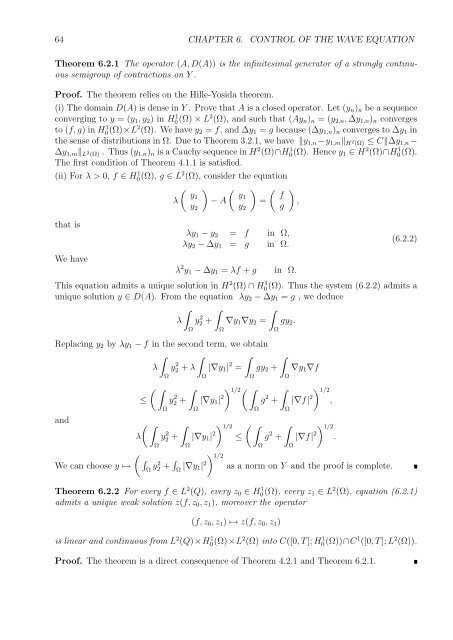Optimal Control of Partial Differential Equations
Optimal Control of Partial Differential Equations
Optimal Control of Partial Differential Equations
You also want an ePaper? Increase the reach of your titles
YUMPU automatically turns print PDFs into web optimized ePapers that Google loves.
64 CHAPTER 6. CONTROL OF THE WAVE EQUATION<br />
Theorem 6.2.1 The operator (A, D(A)) is the infinitesimal generator <strong>of</strong> a strongly continuous<br />
semigroup <strong>of</strong> contractions on Y .<br />
Pro<strong>of</strong>. The theorem relies on the Hille-Yosida theorem.<br />
(i) The domain D(A) is dense in Y . Prove that A is a closed operator. Let (yn)n be a sequence<br />
converging to y = (y1, y2) in H 1 0(Ω) × L 2 (Ω), and such that (Ayn)n = (y2,n, ∆y1,n)n converges<br />
to (f, g) in H 1 0(Ω)×L 2 (Ω). We have y2 = f, and ∆y1 = g because (∆y1,n)n converges to ∆y1 in<br />
the sense <strong>of</strong> distributions in Ω. Due to Theorem 3.2.1, we have y1,n −y1,m H 2 (Ω) ≤ C∆y1,n −<br />
∆y1,m L 2 (Ω) . Thus (y1,n)n is a Cauchy sequence in H 2 (Ω)∩H 1 0(Ω). Hence y1 ∈ H 2 (Ω)∩H 1 0(Ω).<br />
The first condition <strong>of</strong> Theorem 4.1.1 is satisfied.<br />
(ii) For λ > 0, f ∈ H1 0(Ω), g ∈ L2 (Ω), consider the equation<br />
<br />
y1 y1 f<br />
λ − A = ,<br />
g<br />
that is<br />
We have<br />
y2<br />
y2<br />
λy1 − y2 = f in Ω,<br />
λy2 − ∆y1 = g in Ω.<br />
λ 2 y1 − ∆y1 = λf + g in Ω.<br />
(6.2.2)<br />
This equation admits a unique solution in H2 (Ω) ∩ H1 0(Ω). Thus the system (6.2.2) admits a<br />
unique solution y ∈ D(A). From the equation λy2 − ∆y1 = g , we deduce<br />
<br />
λ y<br />
Ω<br />
2 <br />
<br />
2 + ∇y1∇y2 =<br />
Ω<br />
gy2.<br />
Ω<br />
Replacing y2 by λy1 − f in the second term, we obtain<br />
<br />
λ y<br />
Ω<br />
2 <br />
2 + λ |∇y1|<br />
Ω<br />
2 <br />
= gy2 +<br />
Ω<br />
<br />
≤<br />
|∇y1| 2<br />
1/2 <br />
and<br />
We can choose y ↦→<br />
y<br />
Ω<br />
2 2 +<br />
Ω<br />
g<br />
Ω<br />
2 +<br />
Ω<br />
Ω<br />
∇y1∇f<br />
|∇f| 2<br />
1/2 ,<br />
<br />
λ y<br />
Ω<br />
2 <br />
2 + |∇y1|<br />
Ω<br />
2<br />
1/2 <br />
≤ g<br />
Ω<br />
2 <br />
+ |∇f|<br />
Ω<br />
2<br />
1/2 <br />
<br />
Ω<br />
.<br />
y2 2 + <br />
1/2 2 |∇y1| as a norm on Y and the pro<strong>of</strong> is complete.<br />
Ω<br />
Theorem 6.2.2 For every f ∈ L 2 (Q), every z0 ∈ H 1 0(Ω), every z1 ∈ L 2 (Ω), equation (6.2.1)<br />
admits a unique weak solution z(f, z0, z1), moreover the operator<br />
(f, z0, z1) ↦→ z(f, z0, z1)<br />
is linear and continuous from L 2 (Q)×H 1 0(Ω)×L 2 (Ω) into C([0, T ]; H 1 0(Ω))∩C 1 ([0, T ]; L 2 (Ω)).<br />
Pro<strong>of</strong>. The theorem is a direct consequence <strong>of</strong> Theorem 4.2.1 and Theorem 6.2.1.

















